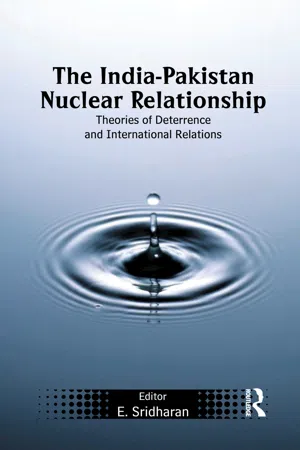
The India-Pakistan Nuclear Relationship
Theories of Deterrence and International Relations
- 308 pages
- English
- ePUB (mobile friendly)
- Available on iOS & Android
The India-Pakistan Nuclear Relationship
Theories of Deterrence and International Relations
About this book
Conflict resolution and promotion of regional cooperation in South Asia has assumed a new urgency in the aftermath of the nuclear tests by India and Pakistan in 1998, and underlined by the outbreak of fighting in Kargil in 1999, full mobilization on the border during most of 2002, and continued low-intensity warfare and terrorism in Jammu and Kashmir. The stability of nuclear deterrence between the two countries is therefore a matter of great urgency and has found a place on the scholarly agenda of security studies in South Asia.
Several books have been written on India's nuclear programme, but these have been mostly analytical histories. The India-Pakistan Nuclear Relationship is a new departure in that it is the first time that a group of scholars from the South Asian subcontinent have collectively tried to apply deterrence theory and international relations theory to South Asia.
Frequently asked questions
- Essential is ideal for learners and professionals who enjoy exploring a wide range of subjects. Access the Essential Library with 800,000+ trusted titles and best-sellers across business, personal growth, and the humanities. Includes unlimited reading time and Standard Read Aloud voice.
- Complete: Perfect for advanced learners and researchers needing full, unrestricted access. Unlock 1.4M+ books across hundreds of subjects, including academic and specialized titles. The Complete Plan also includes advanced features like Premium Read Aloud and Research Assistant.
Please note we cannot support devices running on iOS 13 and Android 7 or earlier. Learn more about using the app.
Information
1 Introduction: Subcontinental Perspectives on Deterrence Theory, International Relations Theory and South Asia
Table of contents
- Cover
- Half Title
- Title Page
- Copyright Page
- Contents
- Preface and Acknowledgements
- 1 Introduction: Subcontinental Perspectives on Deterrence Theory, International Relations Theory and South Asia
- 2. International Relations Theory and the India-Pakistan Conflict
- 3. Conceptualizing Nuclear Deterrence: Pakistan’s Posture
- 4. South Asia: The Irrelevance of Classical Nuclear Deterrence Theory
- 5. International Relations Theory and Minimum Deterrence
- 6. Deterrence and Nuclear Use: Doctrines in South Asia
- 7. The Stability-Instability Paradox: A Less than Perfect Explanation
- 8. Operation Vijay and Operation Parakram: The Victory of Theory?
- 9. Theories of Deterrence and Nuclear Deterrence in the Subcontinent
- 10. The Threat of Unintended Use of Nuclear Weapons in South Asia
- 11. The China Factor in South Asia’s Nuclear Deterrence
- About the Editor and Contributors
- Index